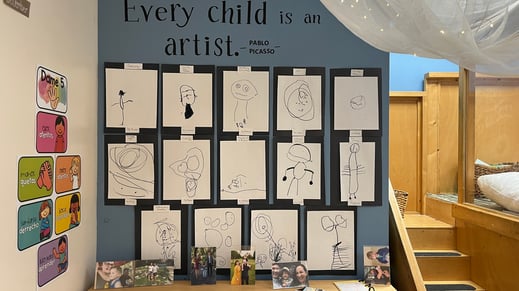
As a new school year approaches, educators stand at the threshold of exciting possibilities. This is the moment to breathe life into classrooms through the power of meaningful interactions by using the principles of CLASS as a guide.
With meaningful, high-quality interactions as the foundation, you can then shape the physical environment to amplify positive behaviors further and nurture high-quality engagement. Let’s explore ways to incorporate CLASS domains into your classroom design and setup!
1. embracing CLASS: It's About Interactions, Not Just Observations
Consider the Classroom Assessment Scoring System (CLASS) not merely as a tool for observing interactions, but as your pathway to enhancing your relationships with children. With CLASS as your guide, you can directly influence positive childhood outcomes. These rich, everyday interactions support each child's academic success, social-emotional development, and enthusiasm for lifelong learning.
2. Emotional Support: Crafting a Safe Haven
Emotional Support is all about creating a nurturing and positive environment where every child feels valued.
Consider creating a reading corner with comfortable seating, an accessible bookshelf, and a small rug to create a cozy ambiance. Include books that represent the children in your classroom, that build off their interests, and that model caring relationships. For older children, try designing a simple 'Kindness Board,' where children can post notes or stickers acknowledging their classmates' good deeds. Small yet intentional modifications and designs can turn your classroom into an emotionally supportive space, effectively reducing challenging behaviors.
3. Classroom Organization: Setting Up for Success
The Classroom Organization domain focuses on the need for an organized and engaging learning environment.
Try using visual schedules with familiar symbols or color-coded activity charts to establish clear routines, reducing uncertainty. Designate a 'Quiet Spot' stocked with a few soft toys and picture books that can serve as a refuge for students needing a moment to calm down. Such intuitive arrangements can help decrease challenging behaviors by setting clear expectations and providing self-regulation tools.
4. Instructional Support: Fueling Curiosity and Engagement
Instructional Support encourages us to ignite children's curiosity and facilitate higher-order thinking.
Consider setting up a 'Question Box' where children can drop their queries or thoughts, spurring critical thinking. Or, design a simple 'Science Station' with everyday items like rocks, leaves, or seashells that children can explore, sparking curiosity and reducing off-task behaviors. Post a list of open-ended questions specific to each learning area in your classroom, to promote communication and deeper thinking.
5. Empowering Practices: Diving Deep with Professional Development
Empower your own teaching toolkit with professional development that offers actionable and relevant strategies to handle challenging behaviors in the classroom. Explore proven training methods like Banking Time, which provides techniques for strengthening relationships with children through meaningful one-on-one interactions. Or consider a bite-sized learning experience focusing on how meaningful interactions can decrease challenging behaviors in the classroom.
Harness the power of meaningful interactions and a supportive environment to transform your classroom into a space where positive behavior thrives!
Discover More Ways to Boost Interactions and Your Environment Here
